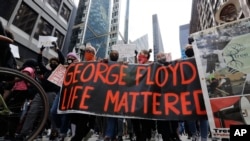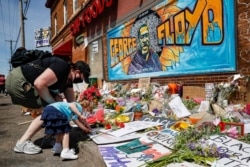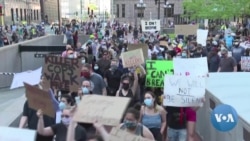Gerald Davis, a 67-year-old small business owner in Washington, D.C., was driving to buy insect repellent at a local 7-11 convenience store Friday night when a van began tailgating him with its high beams on.
“I gave them the courtesy of going by me by pulling over, they stayed behind my truck and it really frightened me...it was clear that this was a harassment situation,” Davis said.
“And what just happened in Minnesota - that’s running across my head.”
Davis saw a police car outside the 7-11 and pulled over - both to buy his bug spray and to speak with the officers about what he had experienced.
“They were so dismissing. They were not even interested in what I was saying,” Davis recounts.
What happened in that moment mirrors what a multitude of black Americans and supporters are are feeling throughout the country today.
“I remembered at 4 years old when I couldn't sit at a soda fountain in my hometown.
That came up. Going to the all-white high school, being one of 12 black kids - the harassment and threats out there. That exploded. The many times I've been stopped by the cops harassing me,” Davis said.
“All that erupted in my gut ... I turned to the cops. I had no fear. And I just said, ‘a black man's feelings are never regarded because white people have been trained, particularly police, to dehumanize them.”
For many who are defying a COVID-19 pandemic to protest around the United States today, the violent death of George Floyd -- who died with a Minneapolis police officer pressing his knee on his neck -- is not a solitary incident, but a tipping point.
In an op-ed for the Los Angeles Times, renowned basketball player Kareem Abdul-Jabbar writes, “African Americans have been living in a burning building for many years, choking on the smoke as the flames burn closer and closer.”
“Right now it’s George, Breonna, and Ahmaud. Before that it was Eric, Sandra, and Michael. It just goes on, and on, and on,” former first lady Michelle Obama wrote on Twitter.
“George Floyd was killed like an animal. And we're tired. This is the norm. This is not something that's new,” demonstrator Diedre O'Brien told VOA at a protest outside the White House this weekend.
Many protesters are worried about the virus - and some note the preliminary data showing black Americans are dying of COVID-19 at a higher rate than their white counterparts.
“I wear my mask, trying to keep a safe distance from a bunch of different people. And I'm also a black woman who has asthma, so I am definitely in the reach of COVID which has been killing black people at a disproportionate rate as well,” O’Brien said.
Data from the COVID tracking project shows that while African Americans account for 13% of the U.S. population, they account for 25% of COVID deaths in the country.
APM Research Lab reports that, according to the latest data, the mortality rate for African Americans is 2.4 times higher than that of white Americans.
But protesters still feel the risk is worth it. Many say it was unambiguous circumstances of George Floyd’s death – as shown on widely distributed videos -- that mobilized nationwide rage.
Davis is not on the streets himself, but he is checking in with his nieces and nephews who are.
“I just talked to them this morning,” he said, noting that he is “scared to death” for them, but that he won’t tell them to stay inside.
“I don't have the energy and the consciousness to tell them not to live their life with creativity, and expect humanity to be treated like human beings.”
Feeling human, feeling listened to, is what Davis says is most important to him right now.
And though he is shaken by his experience last Friday, he notes that while facing the police officers in the convenience store, he did find someone to listen.
“There was a hand that was placed on top of my hand at the counter... I turn my head and this white man looked at me and said, ‘Can I listen to you?’” Davis recounted.
“I don’t know who that man was,” Davis said.
“But in some way, he gave me hope.”
Jason Patinkin contributed to this story.










